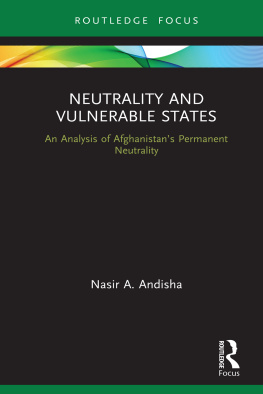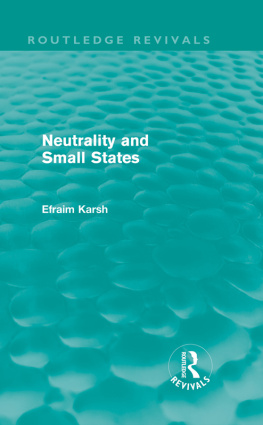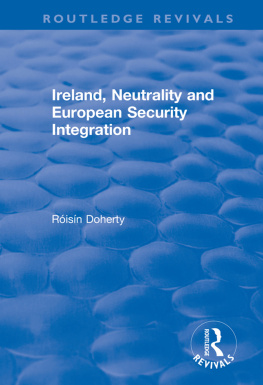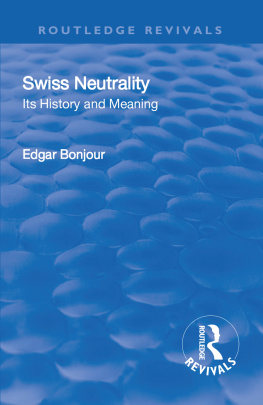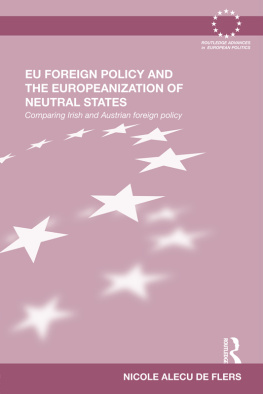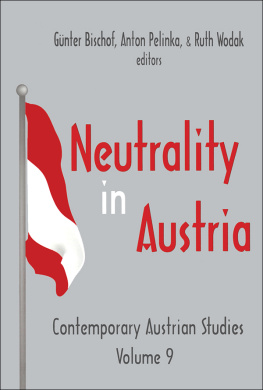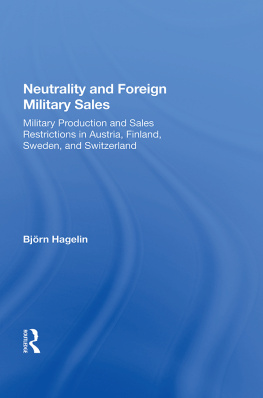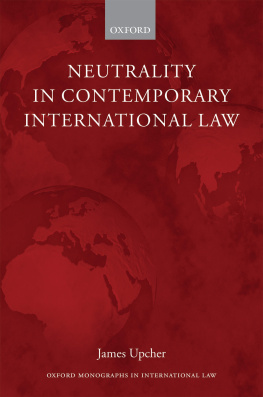Neutrality and Vulnerable States
This book offers a timely and concise academic and historical background to the concept and practice of neutrality, a relatively new phenomenon in foreign and security policy.
It approaches two key questions: under what circumstances can permanent neutrality be applied, and what are the main ingredients of success and the causes of failure in applying permanent neutrality? By evaluating, comparing, and contrasting the two successful European case studies of Austria and Switzerland and the two challenging Asian case studies of Afghanistan and Laos, the author creates a new framework of analysis to explore the feasibility of reframing, adopting, and applying a policy of neutrality and jump start debates on the feasibility of the idea of new neutrality. He opens the debate by asking whether, as neutrality successfully functioned as a conflict resolution tool during the Cold War, a reframed and adopted version of neutrality could also serve the needs of the twenty-first-century world order.
This is an insightful book for all scholars, students, and policymakers working in international relations, security studies, the history of neutrality, and Afghanistan studies.
Nasir A. Andisha is a diplomat and academic. His research interests include international relations, regional security, politics, and governance in South and Central Asia. He received a doctoral degree in diplomatic studies from the Australian National University in 2015. Andisha was a Fulbright fellow at the Bush School of Government in Texas A&M University (20072009), a fellow at the Marshall Centre for European Studies in Garmisch, Germany and the Asia Pacific Centre for Security Studies in Hawaii, USA, and attended the Executive Education Program for Leaders from South Asia at the Kennedy School of Government at Harvard University in 2012. He worked with the International Committee of Red Cross (ICRC) as a field officer (19982001) and taught international relations at the Institute of Diplomacy of the Ministry of Foreign Affairs of Afghanistan and Al-Beroni University in Kapisa Province, Afghanistan.
Neutrality and Vulnerable States
An Analysis of Afghanistans Permanent Neutrality
Nasir A. Andisha
First published 2021
by Routledge
2 Park Square, Milton Park, Abingdon, Oxon OX14 4RN
and by Routledge
52 Vanderbilt Avenue, New York, NY 10017
Routledge is an imprint of the Taylor & Francis Group, an informa business
The right of Nasir A. Andisha to be identified as author of this work has been asserted by him in accordance with sections 77 and 78 of the Copyright, Designs and Patents Act 1988.
All rights reserved. No part of this book may be reprinted or reproduced or utilised in any form or by any electronic, mechanical, or other means, now known or hereafter invented, including photocopying and recording, or in any information storage or retrieval system, without permission in writing from the publishers.
Trademark notice : Product or corporate names may be trademarks or registered trademarks, and are used only for identification and explanation without intent to infringe.
British Library Cataloguing-in-Publication Data
A catalogue record for this book is available from the British Library
Library of Congress Cataloging-in-Publication Data
Names: Andisha, Nasir A., author.
Title: Neutrality and vulnerable states: an analysis of Afghanistanspermanent neutrality/Nasir A. Andisha.
Description: Abingdon, Oxon; New York, NY: Routledge, 2021. |Includes bibliographical references and index.
Identifiers: LCCN 2020019966 (print) | LCCN 2020019967 (ebook) |ISBN 9781138625785 (hardback) | ISBN 9780429459689 (ebook)Subjects: LCSH: Neutrality. | Nonalignment. | NeutralityAfghanistan. |NonalignmentAfghanistan. | AfghanistanForeign relations.Classification: LCC JZ6422 .A64 2021 (print) | LCC JZ6422 (ebook) |DDC 327.581dc23
LC record available at https://lccn.loc.gov/2020019966
LC ebook record available at https://lccn.loc.gov/2020019967
ISBN: 978-1-138-62578-5 (hbk)
ISBN: 978-0-429-45968-9 (ebk)
Typeset in Times New Roman
by Deanta Global Publishing Services, Chennai, India
Contents
A summary of the main theoretical approaches toward neutrality |
A proposed analytical framework of viability and sustainability of permanent neutrality |
The revised analytical framework |
As a concept, neutralitythe choice not to participate in others warshas featured in interstate discourse at least since the Peloponnesian War toward the end of the fifth century BC. However, as an internationally sanctioned policy option, it was formalised during the Congress of Vienna in 1815. Ever since its popularisation as an alternative to recurring conflict facing strategically located small and vulnerable states, this apparently desirable foreign policy choice and convenient diplomatic tool for managing conflict and maintaining a balance of power has frequently been recommended, though intermittently applied. Even a cursory look at the application of permanent neutrality, that is, a formalised type of neutrality, as a state policy of well-known neutrals such as Switzerland, Sweden, Belgium, Austria, Laos, and others indicates a mixed success record.
On the other hand, unlike the concepts of war and peace, the study of neutrality has not been a theme of major academic interest in the discipline of international relations. The scant literature that does exist on the subject mainly focuses on the legal aspects of neutrality.
This book embarks on a dual challenge of explaining a complex and intertwined phenomenon of state neutrality in simplest possible terms and investigating the case of Afghanistan, a former buffer state which observed some form of neutrality in the past. It is argued that over the past two hundred years, Afghanistan has enjoyed stability and tranquillity when the country observed some form of neutrality, and therefore, a return to neutrality could be a return to normalcy and stability. To offer a structured yet simple analysis of state neutrality, this study outlines the circumstances under which permanent neutrality can be applied and illustrates the main ingredients of success and the causes of failure. The analysis of Afghanistans history of neutrality and feasibility and desirability of neutrality as a future course is conducted with the help of a multi-factorial analytical framework drawn from the current literature and augmented through examining Swiss, Austrian, and Laotian neutrality as case studies.
The empirical examination indicates that external factors such as appropriate geo-political positions and importance, balance of power and military stalemates, consensus and agreement of the neighbouring countries and the great powers, and internal factors such as domestic stability and cohesion and military and economic capabilities of the neutral state in varying degrees contribute to a viable neutrality. However, there are new and emerging factors which need to be considered in studying the desirability and feasibility of a policy of neutrality in the context of contemporary international politics. This book presents three new factorsfixed and agreed-upon borders, no active involvement of trans-border non-state actors in the conflict, and cultural and ideological outlooks in favour of permanent neutralitythat are essential pre-conditions for a viable state of permanent neutrality today. The book aims to enrich the otherwise meagre contemporary IR literature on the subject and to explicate the major obstacles that would need to be overcome if Afghanistan were to make effective use of the policy of permanent neutrality in the future.

